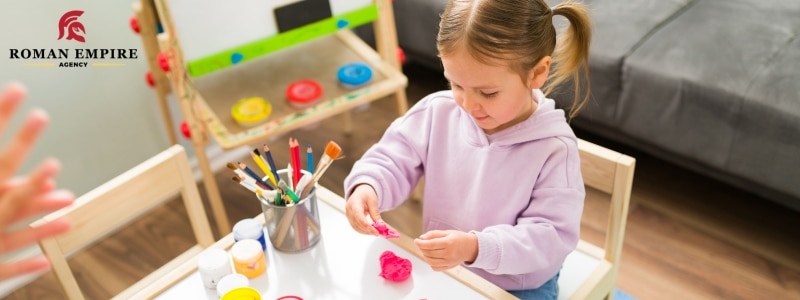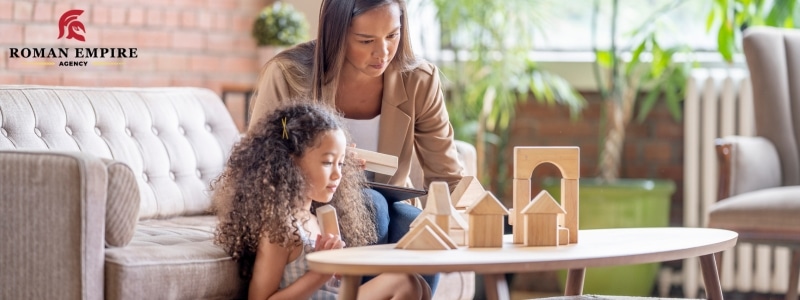
Often used at a young age, play therapy is a form of treatment that alleviates symptoms of emotional challenges.
In this blog, we’ll discuss:
- What is an example of play therapy?
- What is the basic theory behind play therapy?
- What is the typical age for play therapy?
- Why is play therapy so effective?
- What are the four stages of play therapy?
What Is An Example of Play Therapy?
Child-centered play is when a patient leads the direction of a game while therapy is being conducted.
Play therapy for children can include:
- Arts and crafts
- Musical play with instruments or dance
- Water and sand play
- Blocks
- Puzzles and board games
- Dolls
Play therapists will ask patients simple, leading questions when participating in play to better understand them. These activities can also help the child develop problem-solving and social skills when playing.
Play therapy is commonly used to act out real-time situations through role-playing. Using toys such as a doll house, a therapist will ask the child to use dolls to represent their family. This will help therapists better understand home life or the child’s experience. Similar play can be done with puppets or any storytelling games. Getting the child to explain their life like a story will help them discuss moments that are otherwise hard to talk about.
What Is The Basic Theory Behind Play Therapy?

Play therapy works to meet the specific needs of children with developmental disabilities and behavioral challenges. By allowing children to go back to a natural sense of communication, they will be less guarded in talking through their struggles. Using toys as a form of expression instead of words can make overcoming issues more manageable.
Play therapy also centers around empathy and positivity. Uplifting the child through their actions can increase their emotional awareness, communication, problem-solving, and resilience skills. With a natural environment and continued support from the therapist, a child can see the benefits of this therapy.
What Is The Typical Age For Play Therapy?
Play therapy techniques can be applied to people of all ages. While infants, teenagers, and adults can still seek this type of treatment, the typical age range for play therapy is 3-12. Within the foundational ages of someone’s youth, this therapy can give a stable foundation for their future.
Play therapy techniques can be applied to people of any age.
These methods have been proven to be effective in many life circumstances, including:
- Chronic illness
- Medical procedures
- Developmental delays, intellectual disabilities, or dementia
- Family issues- such as divorce or death
- Eating disorders or substance abuse
- Mental illness, PTSD, and anger issues
- Traumatic events or childhood trauma
Therapy is meant to help someone overcome their challenges- and unforeseen circumstances don’t go away with age. Because of this, play therapy can be helpful within any age range.
Why Is Play Therapy So Effective?

There are countless benefits of play therapy. In a safe environment, this therapy relieves stress and boredom, stimulates creative thinking, regulates emotions, and creates a deeper connection to self and others.
Additional benefits include:
- Taking more responsibility
- Increased empathy
- Respect for others and self
- Less anxiety
- Stable communication
- Social and problem-solving skills
Play therapy lets children practice necessary skills without additional stress or outside expectations. Children can begin to think more optimistically with attentive support throughout the healing process.
What Are The Four Stages Of Play Therapy?
Like other types of therapy, play therapy is a journey filled with highs and lows. Through observed treatment, children will experience four clear stages in play therapy.
- Exploratory stage. This stage is the most critical time for mental health development, as the child will begin establishing trust with their therapist and environment. The first stage primarily allows children to explore and become comfortable with the environment- creating a stable foundation for effective play therapy.
- Resistance stage. The child feels pressured to change and often becomes reactive because it’s uncomfortable. The child is expressing their needs and is becoming separate from what they know as familiar. Because of this, the second stage often sees the most resistance and negativity.
- Growing stage. In this stage, the child begins to experience the empowerment of making changes and experiencing a difference. Self-esteem, confidence, and communication often see the most transformational growth in this stage.
- Termination stage. In this stage, the child shows steadfast positive reactions. As they are now stable in their growth, therapy can be stopped.
While each stage presents its unique highs and lows, it’s important to experience each stage to the fullest. Without the completion of one stage, you’re unable to move on to the next. Perseverance will bring you results!






